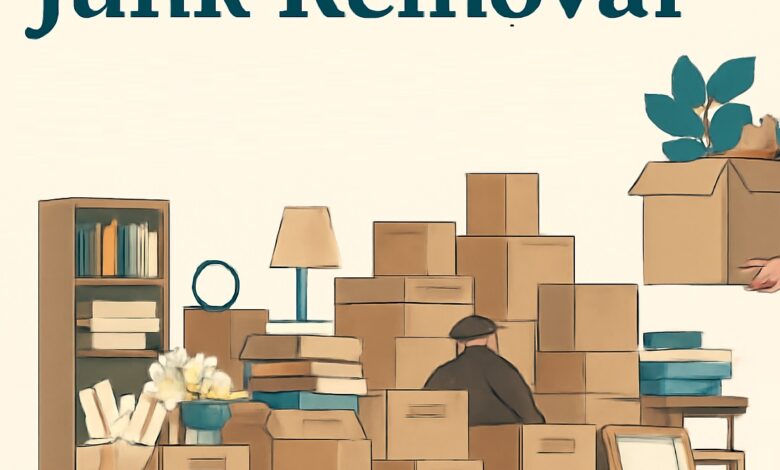Junk Removal: How to Tackle Hoarding and Declutter Your Home

Decluttering your home can feel like a daunting task, especially if you have accumulated belongings over the years. From old furniture to unused appliances, papers, and sentimental items, it’s easy to become overwhelmed. However, the process of tackling hoarding and decluttering your living space can also bring about a sense of freedom and rejuvenation. Whether you’re dealing with a few items that need to go or a full-blown hoarding situation, it’s important to approach the task with a strategy that makes it manageable, and most importantly, positive. In this blog post, we’ll explore helpful tips on how to declutter and tackle hoarding effectively without feeling stressed or defeated.
Step 1: Acknowledge the Need for Change
The first step in any decluttering process is recognizing the need to take action. Whether your space has become a cluttered mess over time or you’re dealing with more serious hoarding behaviors, acknowledging that it’s time to let go of the past and embrace a cleaner, more organized environment is crucial. It’s essential to approach this process with a positive mindset. Clutter often comes with emotional attachment, and understanding that your belongings no longer serve you can make the process smoother. It’s normal to feel anxious about parting with certain items, but keep in mind that letting go can open up space for new experiences and opportunities.
Step 2: Take It One Step at a Time
When faced with a cluttered home, it can be tempting to try and tackle everything at once, but this approach can lead to burnout. Instead, break down the task into manageable chunks. Start with one room or area at a time. For example, begin with the living room, kitchen, or your closet, and focus on sorting through items in that space. This way, you can make progress without feeling overwhelmed. Another helpful strategy is to set a timer for 20-30 minutes at a time, allowing you to focus on the task without feeling pressured.
Taking it step by step not only helps prevent burnout but also provides a sense of accomplishment each time you complete a section. As you continue, the momentum will build, and you’ll be motivated to tackle the next part of your home.
Step 3: Begin Sorting Your Items
Sorting through your belongings is one of the most important steps in the decluttering process. The goal is to categorize your items into three groups: keep, donate, and discard. If an item is something you no longer use, need, or love, it’s time to part with it. Here’s where junk removal services can be especially helpful. For larger items, broken furniture, or piles of things that can’t be easily donated, a professional service can come in and clear the space for you. Knowing that you have a reliable option to handle these items can help ease the burden of decluttering.
However, for smaller items, you may want to consider donating. Many local charities and shelters would gladly accept gently used clothing, books, or home goods. By donating, you’re not only freeing up space but also giving your belongings a second life, which can be immensely satisfying. It’s a win-win!
Step 4: Stay Organized Throughout the Process
As you sort through your belongings, it’s important to stay organized. Make sure you have clear spaces for your “keep,” “donate,” and “discard” piles. This will help you stay on track and prevent unnecessary confusion. It may also be helpful to have bins or boxes on hand to separate items. As you go through your items, ask yourself if each object serves a meaningful purpose or if it’s simply taking up space. If you haven’t used an item in the past six months or it doesn’t bring you joy, it’s probably time to let it go.
Remember, the goal isn’t to purge everything, but rather to create a home that reflects your needs and interests. As you keep only those things that serve a purpose or spark joy, your space will feel more organized and livable.
Step 5: Deal with Sentimental Items
One of the toughest parts of decluttering is dealing with sentimental items. These are the items that hold emotional value and are often the hardest to part with. Whether it’s a childhood toy, family heirlooms, or gifts from loved ones, these objects may carry memories and emotions that make it difficult to let go.
If you find yourself struggling with sentimental items, it’s helpful to pause and reflect. Instead of keeping every single memento, consider taking photos of the items you hold dear. This way, you can preserve the memory without keeping the physical object. Additionally, if certain items no longer serve a functional purpose but hold sentimental value, consider displaying them in a way that brings joy, such as framing photographs or creating a memory box.
Step 6: Dispose of Waste Responsibly
When tackling hoarding and decluttering, it’s essential to dispose of waste responsibly. Some items can be recycled, while others may need to be taken to the appropriate waste disposal facility. Be mindful of hazardous materials like old batteries, electronics, and cleaning products. Many local municipalities offer special collection days or drop-off locations for such items, so be sure to research the best way to handle them.
Proper disposal is key to maintaining a clutter-free environment, and knowing that you’re responsibly handling your waste can provide peace of mind. It’s also worth noting that many junk removal services will assist with recycling or donating items on your behalf, so be sure to ask about eco-friendly options.
Step 7: Celebrate Your Progress
Once you’ve completed the decluttering process, take a moment to celebrate your success! It’s a huge achievement to have tackled a cluttered or hoarded space and transformed it into a more organized, functional environment. Whether you reward yourself with a relaxing day, a favorite treat, or simply enjoy the newly decluttered space, it’s important to acknowledge the effort you’ve put in.
Additionally, to maintain a clutter-free home, consider setting aside time each week or month to keep things organized. Regular maintenance is key to ensuring that your home remains an enjoyable space.
Step 8: Seek Support if Needed
If you’re dealing with a more severe case of hoarding, seeking professional support is crucial. Hoarding can sometimes be associated with mental health conditions, and tackling it on your own may not always be enough. A therapist or counselor can help you address the emotional attachment to objects and provide strategies to let go of items in a healthy way. There are also professional organizers who specialize in hoarding situations, offering hands-on support to help you through the process.
It’s important to remember that you’re not alone in this journey. Seeking help, whether through therapy, professional organizers, or even a trusted friend, can make the process much easier and less overwhelming.
Step 9: Maintain Your New, Organized Space
The final step in the decluttering process is maintaining your newly organized space. Staying organized can be a challenge, especially if you’re prone to accumulating clutter over time. To prevent your home from becoming cluttered again, create habits that encourage tidiness. Set aside time each week to tidy up and ensure that things are put away in their designated spots.
Another great habit is to avoid bringing unnecessary items into your home. Before purchasing new items, ask yourself if they will serve a purpose or if they will just add to the clutter. By being mindful of what you bring into your home, you can keep your living space clean and organized for the long term.
Conclusion
Decluttering and tackling hoarding can be a challenging yet rewarding process. With the right mindset, approach, and support, you can transform your home into a more organized, peaceful, and enjoyable space. Remember, it’s about making small steps, staying organized, and seeking help when needed. The act of letting go of things that no longer serve you is not only freeing but can also bring clarity and joy into your life. By following these steps, you can create a living environment that truly reflects who you are and what you value.
For more tips on junk removal and home organization, check out this helpful video:


